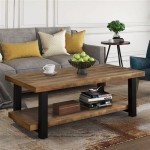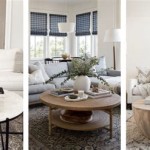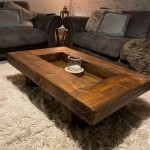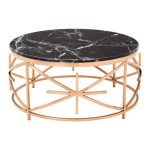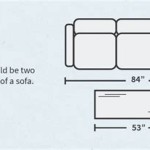Live Edge Burl Wood Coffee Tables: A Statement of Natural Artistry
Live edge burl wood coffee tables represent a unique intersection of natural beauty and functional design. These tables are characterized by their use of burl wood slabs, which are abnormal growths on trees, and the retention of the wood's natural edge, showcasing the organic contours of the tree from which it originated. The combination of these elements results in a piece of furniture that is both a conversation starter and a testament to the enduring appeal of natural materials in interior design.
The allure of a live edge burl wood coffee table lies in its inherent individuality. No two pieces are ever exactly alike. The unique grain patterns, color variations, and the distinctive shape of the live edge ensure that each table is a one-of-a-kind work of art. This variability makes them highly sought after by individuals who appreciate the beauty of natural imperfections and seek to incorporate unique elements into their living spaces.
The construction of these tables often involves meticulous craftsmanship. The burl wood slab must be carefully selected, dried, and treated to ensure its stability and longevity. The live edge is typically preserved, sometimes requiring delicate sanding and finishing to enhance its natural appeal while minimizing the risk of splintering or damage. The base of the table, often made of metal or wood, is designed to complement the slab and provide a stable and aesthetically pleasing foundation.
The popularity of live edge burl wood coffee tables has been steadily increasing as homeowners and designers alike embrace the trend of bringing natural elements indoors. These tables offer a counterpoint to the often-sterile and mass-produced furniture found in many modern homes. They provide a sense of warmth, texture, and connection to the natural world.
Understanding Burl Wood and its Unique Characteristics
Burl wood is a distinctive growth found on trees, often resembling a knotty or rounded protuberance. These growths are believed to be the result of stress or injury to the tree, such as insect infestation, fungal infection, or physical damage. The tree responds to this stress by producing an abnormal growth of densely packed buds and shoots, which eventually develop into a burl. The grain patterns within the burl are often highly complex and irregular, creating a visually stunning and sought-after material for woodworking.
The process of harvesting burl wood is a delicate one. It is crucial to source burls responsibly, ensuring that the trees are not unnecessarily harmed or felled solely for their burls. Sustainable forestry practices prioritize the long-term health of the forest ecosystem. Many reputable suppliers of burl wood work with landowners and loggers to obtain burls from trees that have already been harvested for other purposes or from trees that have fallen naturally.
Once the burl has been harvested, it must undergo a drying process to reduce its moisture content and prevent warping or cracking. This process can take several months or even years, depending on the size and density of the burl. Kiln drying is a common method used to accelerate the drying process, but it is important to control the temperature and humidity carefully to avoid damaging the wood. Air drying, although slower, is often preferred for larger or more delicate burls, as it allows the wood to dry more naturally and evenly.
The unique characteristics of burl wood make it particularly well-suited for creating live edge coffee tables. The irregular grain patterns and swirling figures add visual interest and depth to the tabletop. The natural edges of the burl, with their organic curves and textures, create a sense of connection to the natural world. The density and hardness of burl wood also make it a durable and long-lasting material for furniture.
The Art of Preserving the Live Edge
The "live edge" of a wood slab refers to the natural edge of the tree as it grew, retaining its original contours and bark (or a smoothed version of where the bark was). Preserving this edge is a key element in creating a live edge burl wood coffee table. It necessitates careful craftsmanship and attention to detail.
The first step in preserving the live edge is to remove any loose bark or debris. This can be done using hand tools such as scrapers, chisels, and wire brushes. The goal is to remove any material that is likely to fall off or deteriorate over time, while still preserving the overall shape and texture of the edge.
Once the loose material has been removed, the live edge is typically sanded to smooth out any rough spots and to prevent splintering. The degree of sanding will depend on the desired aesthetic. Some artisans prefer to leave the edge relatively rough and natural, while others prefer a smoother and more refined finish. Various sanding grits are used, starting with a coarse grit to remove any imperfections and progressing to finer grits to achieve the desired level of smoothness.
After sanding, the live edge is often treated with a sealant or finish to protect it from moisture and wear. This helps to prevent the wood from drying out and cracking, and it also makes the surface easier to clean. A variety of finishes can be used, including oils, waxes, varnishes, and polyurethanes. The choice of finish will depend on the desired look and feel, as well as the level of protection required. For example, a natural oil finish will enhance the natural beauty of the wood and provide a soft, matte sheen, while a polyurethane finish will provide a more durable and water-resistant surface.
In some cases, the live edge may require additional stabilization to prevent it from cracking or warping. This can be accomplished by using epoxy resin to fill any voids or cracks in the wood. The epoxy resin can be tinted to match the color of the wood, or it can be left clear to create a contrasting visual effect. The epoxy resin will also help to strengthen the edge and prevent it from breaking off over time. Another stabilization technique is to attach a metal bracket or strip to the underside of the slab, which will help to prevent the wood from warping.
Choosing the Right Base for Stability and Style
The base of a live edge burl wood coffee table plays a vital role in both its stability and its overall aesthetic appeal. The base must be strong enough to support the weight of the burl wood slab, and it must also be designed in a way that complements the natural beauty of the wood.
Metal bases are a popular choice for live edge burl wood coffee tables due to their strength, durability, and versatility. Metal bases can be fabricated in a wide variety of styles, from simple and minimalist designs to more complex and ornate designs. Common types of metal bases include hairpin legs, square tube bases, and wrought iron bases. The finish of the metal base can also be customized to match the overall aesthetic of the table. Popular finishes include powder coating, which provides a durable and scratch-resistant surface, and clear coating, which allows the natural color of the metal to show through.
Wood bases are another option for live edge burl wood coffee tables. Wood bases can be made from a variety of different wood species, including hardwoods such as oak, maple, and walnut, as well as softwoods such as pine and cedar. The choice of wood species will depend on the desired look and feel, as well as the level of durability required. Wood bases can be stained or painted to match the color of the burl wood slab, or they can be left unfinished to highlight the natural beauty of the wood. Wooden bases can be simple designs to show the wood itself or include storage compartments to make the coffee table more functional.
The design of the base should also take into account the size and shape of the burl wood slab. For larger slabs, a more substantial base will be required to provide adequate support. For irregularly shaped slabs, a custom-designed base may be necessary to ensure that the table is stable and balanced. The height of the base should also be carefully considered to ensure that the table is at a comfortable height for use.
The base can be attached to the burl wood slab using a variety of methods, including screws, bolts, and adhesive. It is important to use high-quality fasteners and adhesives to ensure that the base is securely attached to the slab. In some cases, the base may be attached to the slab using a mortise and tenon joint, which provides a strong and durable connection.
Ultimately, the choice of base for a live edge burl wood coffee table is a matter of personal preference and aesthetic considerations. However, it is important to choose a base that is both strong and stylish, and that complements the natural beauty of the wood.

Why Choose A Live Edge Table Tables Redwood Burl Inc

Sold Listing Large Mid Century Free Flow Burl Wood Live Edge

Burl Wood Coffee Table Live Edge Redwood Slab Chairish

Live Edge Burl Wood Coffee Table At 1stdibs Burled Burlwood

Sold Free Flow Live Edge Redwood Burl Coffee Table Israel

Your Custom Listing Amazing Live Edge Walnut Burl Coffee Burled Wood Table Rustic

Vintage Redwood Live Edge Burl Coffee Table C 1960 S16 Home
Black Walnut Burl Live Edge Coffee Table Sleek Rustic Maple Tapered Legs By Saw Wescover Tables

Burled Live Edge Coffee Table Wood Luxe Home Philadelphia

Modern Burl Live Edge Coffee Table Smaller At 1stdibs


